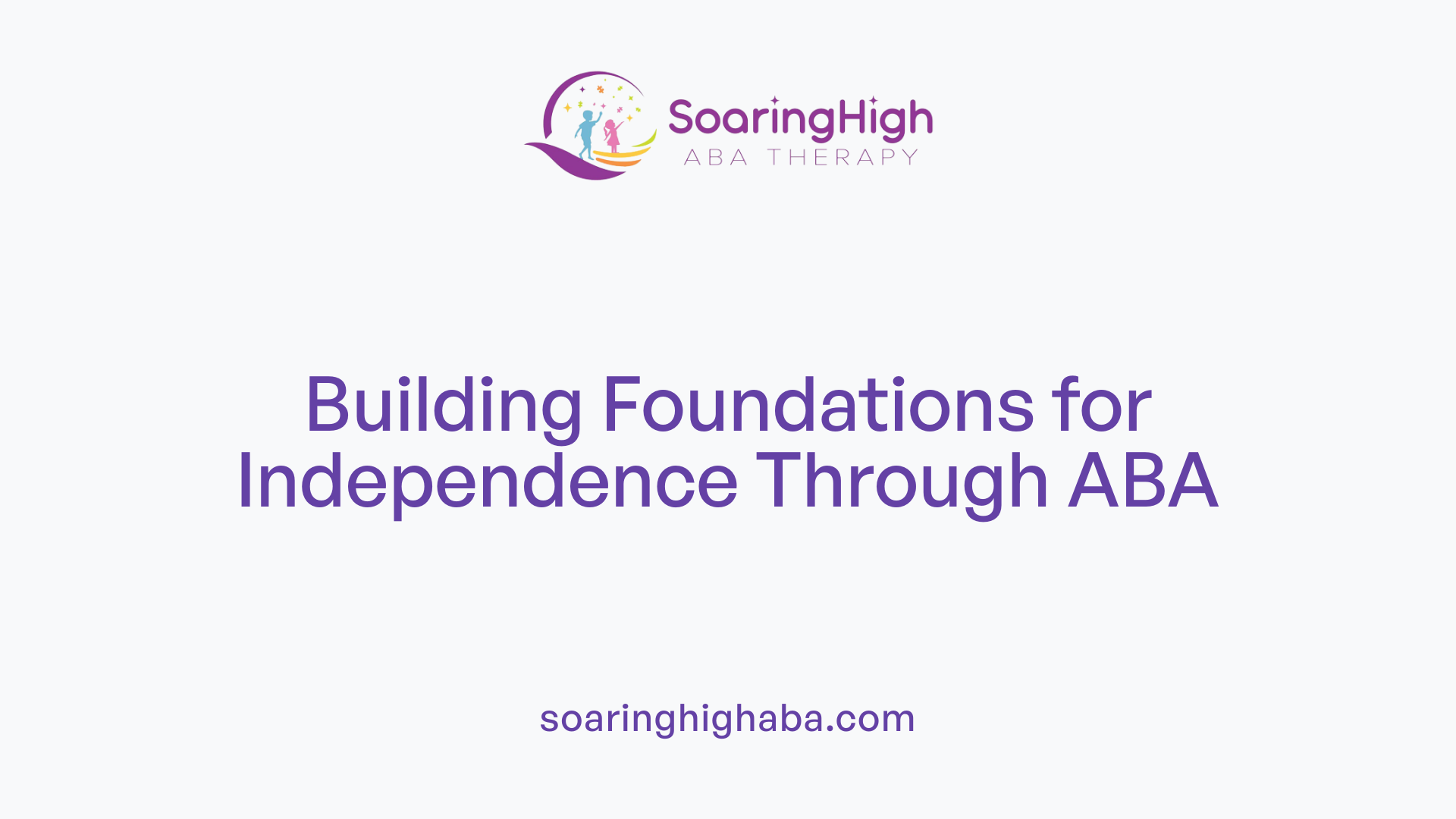Understanding ABA Therapy’s Role in Empowering Children
Applied Behavior Analysis (ABA) therapy is a scientifically supported intervention that plays a crucial role in promoting empowerment and independence among children with autism. Rooted in behavioral science, ABA offers a structured, individualized approach to skill development that significantly enhances communication, social interactions, and daily living skills. This article explores how ABA therapy fosters autonomy, detailing the techniques used, benefits observed, and the lasting impact on children’s lives.
What ABA Therapy Entails and Its Core Principles

What are the principles and goals of ABA therapy related to empowering children?
Applied Behavior Analysis (ABA) therapy is rooted in the science of learning and behavior. Its fundamental principle is that behaviors can be shaped, increased, or decreased through systematic manipulations of environmental factors. Central to ABA is the use of positive reinforcement, which encourages desirable behaviors by rewarding children whenever they perform specific tasks successfully.
The overarching goals of ABA include boosting communication skills, social interaction, self-care, and academic performance. It emphasizes building functional skills that help children become more independent and capable of managing everyday routines.
ABA therapy aims to foster generalization, meaning that children can apply learned skills across various settings—whether at home, school, or community environments. Every treatment plan is personalized based on detailed assessments, making sure strategies effectively target each child's particular needs.
Ultimately, ABA seeks to improve crucial behaviors that significantly influence a child's quality of life. These improvements help children participate more fully in daily activities, nurture their self-confidence, and develop skills that support long-term success in social, academic, and personal domains. This approach not only enhances individual capabilities but also empowers children to navigate their world with greater independence.
What techniques and methods are used in ABA therapy to promote independence?
Promoting independence is a core focus of ABA therapy. To achieve this, practitioners use a variety of techniques tailored to each child's level of development and learning style.
One foundational method is task analysis and chaining, which involves breaking down complex skills—such as dressing or preparing a simple snack—into small, manageable steps. Children learn each step sequentially, gradually building confidence and competence in performing entire routines independently.
Positive reinforcement remains central to ABA, encouraging children to complete tasks correctly and consistently. Rewards can include praise, tokens, or preference items, motivating children to repeat desired behaviors.
Prompting and fading techniques assist children in performing skills independently. Initially, prompts—such as gestures or verbal cues—guide the child through tasks. Over time, prompts are gradually reduced (
Enhancing Key Life Skills for Independence

How does ABA therapy support early childhood development and independence?
ABA therapy plays a vital role in fostering independence in young children, especially those with autism. It accomplishes this by teaching a broad range of foundational skills, including communication, self-care, and social interaction. These skills are imparted using scientifically validated methods like positive reinforcement, prompting, and task analysis.
Through consistent intervention, children learn how their behaviors are shaped by environmental cues and how to adopt adaptive behaviors that facilitate daily functioning. Early intervention with ABA, particularly in preschool-age children, has been shown to improve cognitive abilities, language development, motor skills, and social interaction. This comprehensive approach enables children to become more autonomous in various environments, such as home, school, and community.
Custom-tailored programs address each child's individual needs, focusing on skill acquisition and reducing problematic behaviors. Incorporating play into therapy sessions encourages motivation and social engagement while allowing children to practice skills in a natural, motivating context. This inclusion fosters generalization of skills across settings.
Overall, ABA's structured yet flexible framework promotes independence not only by teaching specific skills but also by instilling confidence and motivation in children. As they master routines and learn to navigate their worlds more effectively, they gain a sense of accomplishment that bolsters their emotional well-being and self-reliance.
What daily skills are targeted in ABA programs to promote independence?
ABA programs aim to develop a variety of essential daily skills that serve as building blocks for independent living. These include self-care routines such as brushing teeth, dressing appropriately, grooming, and managing personal hygiene.
To support a child's ability to manage routines, ABA emphasizes teaching organization skills and establishing consistent routines, which help children learn to manage their belongings and plan their day.
Effective communication is another critical area. Using tools like Picture Exchange Communication Systems (PECS), sign language, and speech therapy, ABA helps children express their needs, participate in social exchanges, and develop language skills.
Emotional regulation also receives focused attention. Children are taught to recognize and respond to their emotions appropriately, which is crucial for making decisions and engaging positively with others.
The systematic approach involves breaking down complex tasks into manageable steps, practicing repeatedly, providing visual supports, and gradually reducing prompts through fading techniques. Such strategies empower children to perform age-appropriate tasks like toileting, managing emotions, and preparing simple meals.
By mastering these daily routines, children gain confidence and autonomy, laying a foundation for lifelong independence. This progress not only enhances their ability to function independently but also positively impacts their self-esteem and social participation.
| Skill Area | Examples of Targeted Skills | Supporting Strategies | |------------------------|----------------------------------------------------|------------------------------------------------|| | Self-care | Brushing teeth, dressing, hygiene routines | Task analysis, visual schedules, reinforcement| | Communication | Expressing needs, requesting, social interaction | PECS, sign language, speech therapy | | Emotional regulation | Recognizing and responding to emotions | Visual cues, coping strategies, parent training| | Routine management | Managing belongings, daily schedules | Visual supports, chaining, prompting | | Personal independence | Toileting, dressing, grooming | Fading prompts, positive reinforcement |
This targeted approach ensures children develop the skills necessary for everyday independence, laying the groundwork for a more confident and self-reliant future.
Behavioral Strategies and Techniques for Building Independence
What techniques and methods are used in ABA therapy to promote independence?
ABA therapy utilizes a variety of evidence-based techniques to foster independence in children with autism. Central to these methods is task analysis, which involves breaking down complex skills into smaller, manageable steps. Chaining then links these steps together to teach the entire skill gradually. For example, a child learning to dress might first be taught to put on a shirt, then pants, and shoes, with each step reinforced until mastered.
Positive reinforcement plays a pivotal role. When a child independently completes a task, they are rewarded with praise or preferred items, encouraging repeated behavior. Prompting methods—like verbal cues or physical guidance—are used to assist initially, and these prompts are gradually faded to promote independent performance.
Modeling and role-playing activities help the child observe and imitate desired behaviors. Visual supports such as picture exchange communication systems (PECS) or visual schedules provide clear, consistent cues that aid understanding and independence.
Therapists continuously track progress through data collection to tailor interventions and ensure skills generalize across settings. All these strategies combine to teach essential skills, reduce reliance on prompts, and boost confidence for greater autonomy in daily routines and social interactions.
Long-Term Outcomes and Benefits of ABA Therapy
What positive outcomes and improvements can result from ABA therapy?
ABA therapy has demonstrated remarkable long-term benefits for children with autism, primarily by fostering essential skills that support independence and social integration. One of the most notable achievements is the enhancement of communication and language abilities. Through techniques like picture exchange, speech therapy, and reinforcement, children learn to express their needs more effectively, leading to better social interactions and relationships.
In addition to communication, ABA therapy cultivates adaptive skills necessary for daily life. Children develop independence in self-care routines such as dressing, grooming, managing emotions, and completing household chores. These improvements significantly boost their confidence and self-reliance.
Behavioral challenges like tantrums, aggression, and self-injury are addressed through targeted strategies, which improve emotional regulation and reduce problematic behaviors. As a result, children tend to exhibit more appropriate actions, contributing to safer and more positive environments.
Children with lower baseline adaptive functioning often experience meaningful, measurable progress over sustained therapy periods. Extensive research supports the notion that intensive ABA interventions lead to overall developmental improvements, enabling children to better navigate their social and learning environments.
While some challenges—such as maintaining progress or dosage variability—exist, the supportive scientific evidence consistently emphasizes ABA’s effectiveness in delivering positive long-term outcomes across a spectrum of behaviors and skills.
What are the long-term benefits observed from intensive ABA interventions?
In the long run, children undergoing intensive ABA therapies often demonstrate notable improvements in intellectual and adaptive domains. These gains include better problem-solving abilities, higher language competence, and increased independence in daily activities.
Early and sustained interventions help children integrate more fully into educational settings, participate actively in social and community activities, and develop emotional resilience. Over time, children typically exhibit more sophisticated social skills, such as understanding social cues, engaging in reciprocal interactions, and establishing peer relationships.
The cumulative effect of these developmental advances extends beyond immediate skill acquisition. Many children achieve higher levels of self-confidence and self-advocacy, empowering them to pursue greater autonomy.
Research indicates that children who receive intensive ABA therapy tend to experience enhanced quality of life, with increased engagement in daily routines and improved mental health. These children often attain milestones that foster lifelong independence and social participation.
Despite challenges like the need for ongoing support or potential variations in treatment intensity, the overall evidence supports early, long-term ABA intervention as a foundational strategy for meaningful, lasting developmental improvements. It lays the groundwork for children with autism to lead fulfilling, autonomous lives and successfully participate in society.
| Aspect | Outcomes | Additional Details |
|---|---|---|
| Communication | Improved vocabulary, better expression | Techniques include PECS, sign language, and modeling |
| Social Skills | Better eye contact, turn-taking, understanding emotions | Focuses on social cues and peer interactions |
| Behavioral Reduction | Fewer tantrums, aggression, self-injury | Uses positive reinforcement and functional assessments |
| Daily Living | Self-care, independence, routines | Task analysis, visual supports, and chaining |
| Cognitive Skills | Enhanced problem-solving, reasoning | Custom strategies tailored to each child's needs |
| Emotional Well-being | Increased self-confidence, self-regulation | Coping strategies, emotional recognition training |
ABA therapy continues to be a powerful, evidence-supported approach for improving the overall quality of life for children with autism, enabling them to reach their full potential and thrive in their communities.
Empowering Children for Lifelong Independence
ABA therapy stands as a powerful, evidence-based approach for fostering empowerment and independence in children with autism. By systematically addressing core developmental areas—such as communication, social skills, and daily living routines—ABA equips children with the tools and confidence needed to navigate the world more independently. Its individualized strategies, including task analysis, positive reinforcement, visual supports, and behavioral shaping, promote lasting skills that benefit children across their lifespan. As research continues to support its effectiveness, ABA remains integral to early intervention and ongoing development, ultimately helping children reach their full potential and enhancing their quality of life. The active involvement of families further amplifies positive outcomes, creating supportive environments where children can thrive.
References
- 5 Ways ABA Therapy Supports Your Child's Independence
- Promoting Independence for Children with Autism - Astra ABA
- Benefits of Applied Behavior Analysis (ABA) Therapy for Children
- Top 7 Benefits Of ABA Therapy For Autistic Children
- Importance of ABA Therapy in Early Childhood Development
- The Benefits of ABA Therapy for Children with Autism
- How ABA Therapy is Transforming the Lives of Children with Autism
- Part 8: Unleashing your Child's Full Potential with ABA Therapy
- 7 Surprising Benefits of ABA Therapy for Kids You Need to Know





































































































